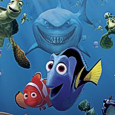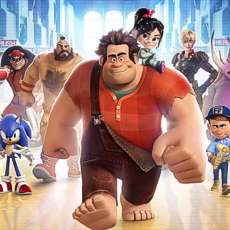Disney/Pixar (May 30 2003), Walt Disney Home Entertainment (December 4 2012), 5-Disc combo pack with Blu-ray 3D and two Blu-ray discs plus DVD and Digital Copy, 100 mins plus supplements, 1080p high-definition 1.78:1 widescreen, Dolby True-HD 7.1, Rated G, Retail: $49.99
Storyboard:
When little clownfish Nemo is fished out of the ocean, his father Marlin sets out on an epic journey of discovery to find him…
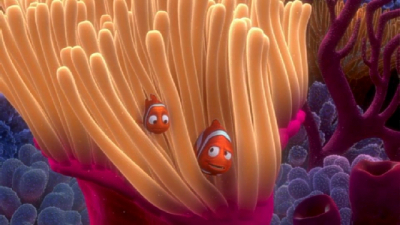
The Sweatbox Review:
Theatrically re-released around a month ago as Disney’s latest catalog title 3D conversion, it seems audiences were wary this time of the obvious marketing tactic (essentially a giant advertising reminded of the movie) and elected to wait just a few short weeks for Finding Nemo’s almost concurrent Blu-ray debut, where I believe it will make much of a splash. The film remains one of my most favorite Pixar pleasures; it’s a film that I’m always happy to watch again whenever and wherever it plays…not just for the sheer pleasure, but to study it further and take it all in, which this new HD transfer offers the chance to do all over again.
I remember vividly seeing Nemo as one of the early all-digital projections, which in those days commanded a slightly higher fee as one would have to travel to an updated theater. In the weeks after Nemo came out, I spent over $80 on the film: from $35 to see it digitally (I paid for a friend also), $20 for Thomas Newman’s soundtrack score on CD, and then $30 on the DVD – and still had a ways to go before being all Nemo’d out! At the center of it all, I think its fairly small and intimate story, albeit told on an epic scale, is what grabbed me. It has, in short, a lot of heart, but it otherwise deceptively simple, and classic Disney in many ways: family suffer tragedy, family must undergo further turmoil on a physical and emotional journey that, at the end of their quest, resolves their personal issues and makes them better people. Or, in Nemo’s case, fish. But you get the idea.

As with many films to emerge from the Disney Studios over the years, it’s the death of a parent that sets the plot in motion, when Nemo’s mother and almost all of her eggs are lost to a barracuda attack at their home under the sea on the great barrier reef. Thankfully, at this point, little Nemo has yet to be born and escapes the predator unharmed as the only surviving egg. His dad Marlin lavishes extra care and attention on Nemo as he grows older – something that does not always sit easy with the little fish himself, especially when his dad’s overprotecting nature embarrasses him on his first day at school. Nemo swims off, trying to prove that he can take care of himself, but soon gets tangled up (quite literally) in a diver’s net and taken away from Marlin and the school.
His dad tries to keep up with the divers’ boat but loses them, with the only clue to their destination being a swim mask that falls to the bottom of the ocean. Marlin meets up, and is teamed with Dory, who suffers from short-term memory loss (providing many of the film’s best and unexpected moments of comedy) and together they vow to find Nemo and bring him home. Meanwhile, our little flipper has ended up in the fish tank of an Australian dentist – a tank filled with other fish desperate to escape due to their being tortured by the dentist’s niece, Darla. Like Sid in Toy Story, Darla is a bit of a psycho (complete with Bernard Herrmann’s unforgettable string theme), and deadly to all fish. Will Marlin, Dory, a team of stoner-surfing turtles and a crazy pelican be able to reach Sydney in time and stop Nemo from becoming sushi? Does the fact that there’s a sequel on the way hold any clue!?

Actually, there’s an interesting comparison to be made there: nowadays Pixar seems to have lost a little of the independent spirit that made them unique, with a (some might say over)-reliance on sequels and building franchises, but back when Finding Nemo was first releases, the company was right in the middle of their own mini-golden age, building on their initial successes and developing more as artists and storytellers. To be honest, I was becoming a little tiresome of the double-acts that seem to populate all of their films at that time. Woody and Buzz’s relationship in Toy Story naturally powered that whole enterprise, and A Bug’s Life added a few additional elements, but however great Monsters, Inc. was – and it was great! – the samey-samey formula was beginning to wear thin.
However, with Nemo and perhaps, looking back on it again now, because they are fully-formed adults instead of characters with younger mental ages, I find the Albert Brooks-Ellen DeGeneres partnership still offers much more than the usual, very much stuck-in-the-same-mould recipe as produced Woody and Buzz, and Mike and Sully. The playing here means that, while they’re together for much of the film, it’s not so buddy-buddy as before, with Marlin acting as a real father the whole way through, and Dory as his sweet-natured but forgetful friend. That there is never any allusion to them becoming romantic partners helps this relationship remain valid and believable (for a fish movie!) and helps the audience tap into this amazing world and maintain our suspension of reality.

It also seems to me now that Marlin’s journey is not just about finding Nemo, but finding himself too, not that Andrew Stanton’s film lapses into moments of overblown pathos – far from it: Nemo also has much of the trademark Pixar humor in bucket loads. The trick here is to watch whoever on screen is not doing the talking and you’ll find that you’ll get twice the laughs! Backgrounds in Pixar’s films are also things to check out, especially in HD, and here there are some great details to find (such as trinkets and characters from the Studio’s then-upcoming movies Cars and The Incredibles). Dialogue in Pixar films is also always very strong, and the actors help pay off any lackluster lines that are to be found here. Not that there are many: Stanton’s script bounces along, and always tops itself up if there is a lull approaching.
The new high-definition transfer is amazing: sometimes Pixar’s films can look too digitally clean, and I often find it odd that the company that also markets the industry standard computer tool RenderMan, an application that is used by many of the top effects people in the business to compose shots and place CG objects into live-action environments, strangely seems to find using this powerful application in their own movies a little “difficult”. On more than one occasion I have been jolted out of a Pixar movie by some fills and textures that just do not seem “finished” (my least favorite character in this respect remains Mike from the Monsters films, who does not seem organic to me at all, although this may be because he is continually paired with the amazingly lifelike Sully and simply comes off a poor second).
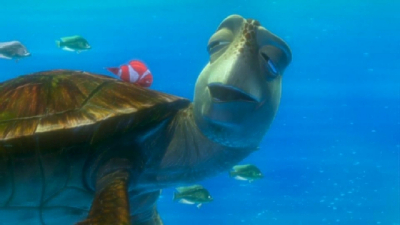
I was a little worried that the same issues might arise again with Nemo, perhaps with the characters floating around onscreen and not feeling like part of their environment, especially with the crispness of HD, but am pleasantly surprised to find that pretty much all elements mesh quite nicely together and the character animation, raised up several notches at the time of release, remains just as good as if it had been produced this year, proving that Pixar were always ahead of the curve. Stanton was, too: predating his later WALL-E, there are moments in Nemo when dialogue does not have to be spoken to convey an emotion – something that CG usually handles by playing everything broad. Subtlety is in great supply here, although the voice cast do get to play a wide range of emotions.
Nemo was also arguably Pixar’s first “big cast” film. While others to this point had a very decent array of talent, such as A-listers Tom Hanks, Tim Allen, John Goodman and Billy Crystal, Finding Nemo goes less for the then-current star names and fits the voices to the personalities. As Marlin, the once-hot but now almost semi-retired Brooks portrays the father with several layers usually missing in his caricatures he sometimes plays in The Simpsons. DeGeneres, before hitting her stride as a national talk-show host treasure, practically plays herself, and comes off best with some of the funniest vocals – speaking whale is a high point!
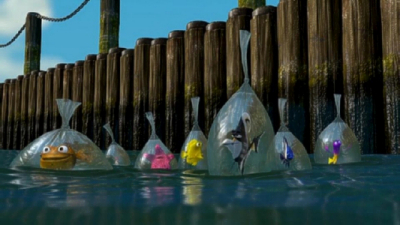
As for the rest, well, how’s this: Willem Dafoe, Geoffrey Rush (making something of a Disney career for himself with this and the Pirates Of The Caribbean series), Barry Humphries (Dame Edna him/herself), Hulking Eric Bana, Austin Pendleton (perhaps best known to readers of Animated Views for The Muppet Movie), Elizabeth Perkins, and animation stalwarts Brad Garrett (various Disney toon series), Stephen Root (King Of The Hill, Ice Age), plus a couple of Pixar crew as additional voices: particularly touching is hearing storyman Joe Ranft as Jacques, while Stanton voices Crush, the memorable turtle who helps Marlin and Dory along their way and almost steals the film.
Making his customary Pixar appearance is John Ratzenberger, and way down in the list is Nicholas Bird, the son of The Incredibles and Iron Giant director Brad, here making his first foray into animation. My one small bugbear with Finding Nemo overall is that despite several re-watches over the years, it still appears to have three endings, one too many for me. Once Nemo has been found, I can see the point of including his final rescue of the other fish in the fisherman’s net, but it does feel a little tagged on, only really being there to prove that he can now fend for himself (although this is something that he in fact does repeatedly throughout the film), and as an additional action sequence.
Perhaps some of the problem is that the fish in the net are, on the whole, totally indistinguishable from one another and, after an hour and a half of very strong, very entertaining characters, personalities and storytelling, it maybe needed a “comedy fish” or someone worth rooting for within the group to help carry the sequence along. That said, it rounds the film up and finishes things on a high note, even if I still wanted things to wrap up a little quicker. But there are plenty other high note moments throughout the film too, as well as the many in-jokes and pokes at Pixar and Disney’s past – the Pizza Planet truck makes another appearance, as well as the mermaid from Knick Knack, and one of the boats the characters fly past in the dock is named Skiff-A-Dee-Doo-Dah (another is The Surly Mermaid).

A quick rendition of A Whale Of A Tale always makes me smile – it’s Ned the sailor’s song from 20,000 Leagues Under The Sea (1954), the live-action Disney film that featured a captain named…Nemo! There are also references to Aardman Animation’s trademark style in the seagulls, with their pointy heads and dotted eyes, as well as their Wallace And Gromit characters, who live at 62 West Wallaby Street in those films: here the dentist’s office is located at “nearby” 42 Wallaby Way! Most obvious to movie-heads, of course, is Barry Humphries’ shark Bruce, named for the often malfunctioning mechanical monster in Steven Spielberg’s Jaws that got given Spielberg’s lawyer’s name for fun. Also, be sure to stick around for some nice touches during, and after, the final credits.
There is so much to like about Finding Nemo, especially in the still vastly impressive visuals. It’s naturally light years ahead of what was possible in such films as The Incredible Mr Limpet, and most certainly contains the funniest fish in a movie since Monty Python’s The Meaning Of Life! It’s a little bit of a shame that Stanton’s John Carter adaptation failed earlier this year: it’s all too obvious for him to return to Nemo’s world for a sequel even if he is doing it for the right reasons. If it was down to me, I’d set him up with a Clint Eastwood-style deal to churn out a Nemo alternately to each new Carter movie: let’s hope that a second Nemo will at least offer him the chance to stretch out again. In the meantime, we have the untouchable original: Finding Nemo can only truly be described adequately as “a fish called wonder”.
Is This Thing Loaded?
A Pixar DVD was, for a time in Disney releases, the only plaice for appreciators of behind-the-scenes material to get their annual supplemental fix, and it does seem that this thinking has been carried over to Blu-ray, with Pixar’s discs usually containing much more added content than a regular Disney Animation release. It’s certainly been the case with 2012’s three feature Pixar titles: Brave and 3D reissues for Finding Nemo and Up all contained a dedicated disc of additional bonus material. Here it seems Nemo’s new HD extras were assembled a little while ago, perhaps for a release earlier this year to coincide with Stanton’s John Carter but then held back to allow for the opportunistic 3D reissue…?
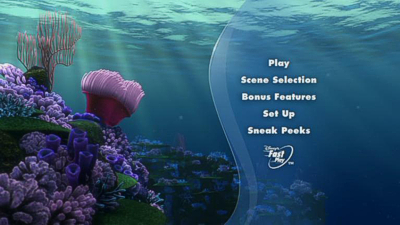
This may explain the presence of the excellent Cine-Explore visual commentary, an always welcome feature that mixes a standard audio commentary with pop-up images and video onscreen, adding a picture-in-picture element to offer an improved presentation in experiencing what goes into a movie like Nemo’s production. This presentation naturally replaces the Visual Commentary featured on the original DVD, which branched off to show additional production footage, alternate and deleted scenes within the movie, but otherwise I do believe this is the same basic audio track, featuring directors Andrew Stanton and Lee Unkrich and co-writer Bob Peterson, as heard before now given the new visual additions.

The commentary itself is what you’ll expect: interesting, never boring, insights into the production with the three filmmakers, which covers absolutely all areas of production. The speakers are placed left, center and right across the soundstage, so even when there is overlap, they all remain clear. Although the near 30-minutes of video-based material is no longer branched outside of the commentary, those pieces have been used to some extent within the picture-in-picture elements and elsewhere around the disc, serving up an amazing amount of intricate detail, such as revealing the initial tests for the anemone was Monsters’ Sully’s hair thickened up a little and lots on the creation of the soundtrack and visuals.
All three BDs’ Main Menus are also neat; dropping the character vocals from the DVD to present various “virtual aquariums”: click the icon at the bottom to remove the menu options and simply enjoy Pixar’s backdrops! As before, the short film Knick Knack that played with Nemo in theaters is also included and, again as before, this is not the original version of the film that debuted at a pre-Disney Pixar in 1989. At the time a bunch of more carefree guys, John Lasseter and his crew knew what assets they appreciated in eyeing up an attractive lady – and you can guess where their attentions lay!
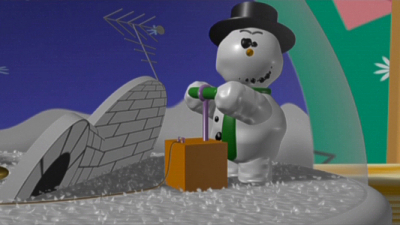
However, by the time of Nemo’s 2003 release this “Disneyfied” edition perhaps reflects their embarrassment at their almost teenaged-outlook on the female anatomy, and so the rather obvious “charms” of a couple of well-endowed figurines have been removed, to be replaced with…well, not much at all actually! The short famously follows the attempts of a snow-globe bound snowman to break free and party with the other keepsakes on display high up on a shelf, and part of the reason (actually, probably the only reason) he wants out is to pursue the girls, and though the original caricatures were admittedly not exactly politically correct, the whole thing was done tongue-in-cheek and as an obvious joke (the girls are made of plastic, after all).
That the main joke has been taken away does not detract from the comic actions of the snowman in any way, but it does subdue his initial reaction, and I’ve seen far more suggestive things TV since. The changes will make no difference for anyone seeing the short for the first time, but for us older fans, it’s just not quite the same. Otherwise, the three and a half-minute Knick Knack on this disc is saved from too much scoffing though, as it is presented in a pristine HD transfer, even if the optional DVD commentary has now been reserved for the Pixar Shorts Volume 1 collection.
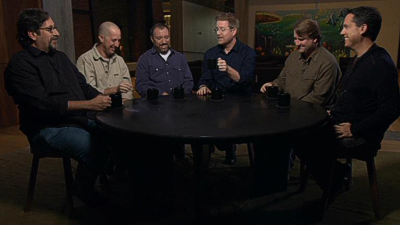
Just shy of being a true tenth anniversary retrospective, Finding Nemo: A Filmmakers’ Roundtable (17:37) follows other recent Pixar Blu-ray debuts by reuniting the principle creators of the movie (Stanton, Unkrich, Peterson, producer Graham Walters, production designer Ralph Eggleston and technical lead Oren Jacob) for a fascinating and funny discussion that looks back on the production. Just as interesting, if not more so, is the work that went into Reinventing The Submarine Voyage (15m) at Disneyland as a Nemo-themed revamp a few years ago. Updated from Walt’s original (and honestly dated) ride, the new-look Tomorrowland attraction is much more fun, and still a wonder as to how animated CG fish can inhabit the ocean we view from the subs’ portals – magic!

A Stanton-introduced alternate opening is presented as a newly-seen Deleted Scene (3:05) from animated story sketches that sets up the over-protective Marlin for a different version of the movie that the eight minute A Lesson In Flashbacks elaborates upon. Stanton remarks on this earlier Nemo in which the film’s barracuda opening was to have been stretched throughout the movie as a series of flashbacks; an interesting juxtaposition that reaches its colliding point in the film’s eventual climax (one shot that echoes this idea remains in the film) and might have played out well had it not given the film a slightly pretentious feel, more art-house than broad commercial animated feature.
On to the second Blu-ray Disc’s bonuses, where there are six more of the dedicated Aquariums to be found under the descriptive titles of Anemone, Jellyfish, Plate Coral, Reef, Sandy Reef and School Of Fish. From the DVD, an Art Review (8:38, now in HD) takes a look at pre-production concept art produced for the film with commentary from production designer Ralph Eggleston, character art director Rick Nierva and shading art director Robin Cooper, the trio introducing themselves with drawn caricatures and talking us through the paintings, allowing for images to be still-framed for closer inspection.

For the first time in Pixar’s history, a documentary crew followed the production through from conception to completion, and the excellent 25-minute Making Nemo is the result; part promo fluff, part meaty doc, the film features interviews with the main players as well as research footage, test animation and the general craziness that is Pixar Animation Studios. Packing in a great deal and covering a lot of in-depth ground for a relatively short piece (such as the visuals dangers of making Nemo’s world too real), the pacey editing keeps things moving along so as to provide an interesting and fun time-capsule of the production, the only disappointment being that it marks the start of the original DVD’s carry-overs in standard definition only.

Exploring The Reef is a seven-minute look at the real world in which Nemo is set, with Jean-Michel Cousteau hosting as if this is going to be one of those “around the world” pieces often shown on nature channels. Any doubt that this is going to be anything less than fun is quickly thrown out as Cousteau is joined onscreen by Dory, Marlin and Nemo by way of obviously exclusive animation. Meshed in with the beautiful (and real, of course) live-action backgrounds, this is highly amusing as Cousteau tries to keep things fact-based while the cast play havoc with his narration. The animated cast themselves don’t always fit it with their real world counterparts, but this is very well-made and we learn quite a few things along the way too – no bad thing!
Young Nemo vocalist Alexander Gould’s quest to find out how they turn his vocals into a fully animated character is next: Studio Tour is a kids-eye view of the Pixar complex, a zippy five or so minute journey that takes in storyboards (“kinda looking like a big comic book”), character design, animation (“animators are kind of like actors, but we act through the computer”), lighting and effects. Though it covers much of the same ground as the documentary, this is aimed at a younger audiences and is worth checking out for its infectious Pixar spirit, which reminds greatly the feel of the Disney Studios in the 1940s behind the scenes movie The Reluctant Dragon.
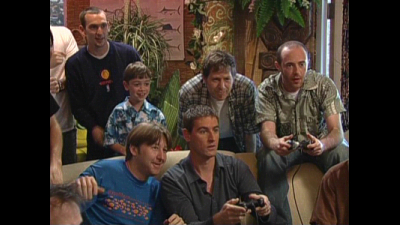
Some of the DVD’s visual commentary footage not used in the new Cine-Explore presentation is gathered under an Old School banner, touching on numerous subjects. El Capitan Pitch Selects doesn’t make much sense without the commentary context, but you can guess what School Progression Reel is; other quick-fire topics include MA Reference, Whale Mouth, International Mine (a few brief seconds of multi-language seagulls!), Pelican Animation, a poignant tribute to animator Glenn McQueen that runs almost three minutes in itself, and an Aquascum 2003 commercial, adding up to around nine minutes of content.
The remainder of that footage can be found in a two minute Outtakes section of vocal booth recordings including DeGeneres improvising her sleeping state, which is fairly amusing, and Brooks delivering variants on Marlin’s joke. Selectable under their Chickenfish, Dory Muttering, Rove McManus and Brooks Punch Lines titles, I would have preferred more than just these as representing the voice cast overall, which was also one of my gripes with the original DVD. A further six minutes of Deleted Scenes from the DVD include more transcendental takes on Crush and Dory, an extra shark scene featuring a game played with a live mine, Marlin searching for Nemo’s school, a longer Nemo in the sewer sequence, an alternate “dream story” version of Nemo’s mother’s death, a not-so-nice side to Gill – all shown in their original storyboard forms.
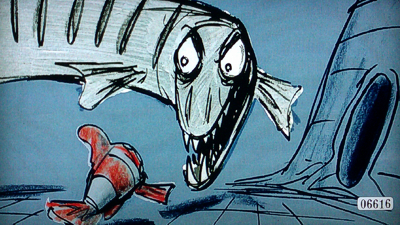
A Publicity Pieces section begins to round things out, featuring four Theatrical Teasers and Trailers that helped Finding Nemo open to such box-office bonanza takings. Unfortunately, in keeping with the SD nature of the DVD material, these haven’t been upgraded to HD, but my feeling is that it’s better to have them rather than not at all, as has been the case with most recent Disney issues: the teaser and three full previews are here, plus three Fishy Facts on Bruce, Crush and Nigel that ran as TV spots. Helping to make up the 13 minutes here are an additional montage of ABC spots and the DVD’s Easter Eggs, now grouped together instead of selecting individually, although a Play All option would have been welcome across all the sections.
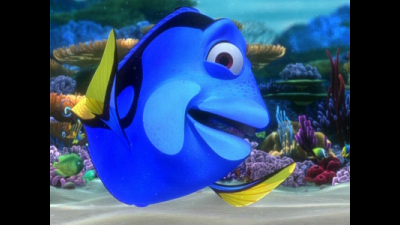
Finally, Mr Ray’s Encyclopedia takes an educational (but always fun) look at the real-life undersea stars of Finding Nemo, with live-action footage of thirteen of the species shown in the film accessible from an interactive encyclopedia. Playable individually or all together, this adds up to over seven and a half minutes of material and enhances the viewing of the movie due to highlighting the attention to detail the crew maintained, as well as providing kids with a real knowledge of how these creatures live and survive – even if Mr Ray isn’t always too hot on his information!
On the enclosed DVD, you’ll find the Knick-Knack short, Filmmakers’ Roundtable and a main menu Aquarium, plus Sneak Peeks for Monsters, Inc. in 3D, Monsters University, Peter Pan: Diamond Edition, DisneyJunior’s Sofia The First series and Planes, now apparently flying into theaters instead of the Cars video spin-off it was originally intended as.
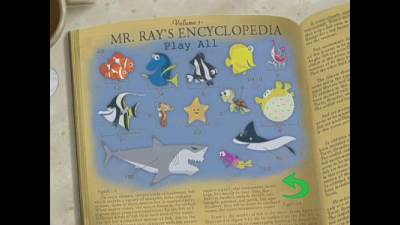
WHAT’S MISSING?
It seems the inflated chests on the female knick knacks in Knick Knack aren’t the only things missing in action! I usually save these kinds of Animated Views comparisons for Disney’s Platinum or Diamond Edition releases, but Finding Nemo comes so close to retaining all of the previous DVD’s material that what has been dropped is puzzling to say the least as to why it’s not here. In a Design Galleries section, the DVD offered additional options to the Art Review pulled over to this disc, studying the sculpted maquette Characters, a series of still image Environments (under three Reef, Ocean and Harbor locations), and over 300 of Eggleston’s Color Script mood drawings.
A slight but fun Fisharades game is more understandably absent, but an interactive Storytime read-along was designed with illustrations that reminded me of the Little Golden Books issued when the film was in theaters, animated and including additional music, dialogue and songs from the film but sadly not featured here. Some small snippets of material seem to have floated away too, but most notable are some Character Interviews, which took in new animation and joke cast chats with Marlin, Dory, Nemo and Bruce the shark, while an international Print Gallery featured 18 poster images.
Case Study:
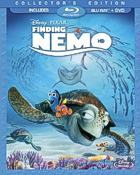 Joining the almost concurrently released Brave on Blu-ray in the same timeframe, Finding Nemo has also been branded an Ultimate Collector’s Edition, sporting each disc version available: the regular Blu-ray, Blu-ray 3D, standard DVD, and an enclosed Digital Copy disc.
Joining the almost concurrently released Brave on Blu-ray in the same timeframe, Finding Nemo has also been branded an Ultimate Collector’s Edition, sporting each disc version available: the regular Blu-ray, Blu-ray 3D, standard DVD, and an enclosed Digital Copy disc.
I actually prefer the packaging for the other versions available: the regular non-3D and stand-alone DVD issues for this release [pictured right] being less cluttered and following previous home video issues by focusing on Marlin, Dory and Crush, which might have worked better given the 3D lenticular treatment awarded the front cover here.
This being a 3D release, the front has been spruced up with just such a dimensionalized lenticular here, but although the use of an earlier, character-packed theatrical poster is welcome, there’s just too much going on to be able to really pick them out and everything becomes something of a fuzzy mess, especially Bruce the shark, who blends so much into the background as to be almost invisible, giving the image the impression of being mis-composed.
Otherwise it’s business as usual, with the sleeve pleasingly not calling the film “Finding Nemo 3D” but featuring disc art across all the platters, except for the bright yellow digital file disc. Inside, the five-disc Blu-ray case includes a Movie Rewards code and a booklet with “more to sea inside” that turns out to be the usual promos for other Disney and Pixar products and Blu-ray releases. There’s nothing unknown or truly unexpectedly awesome announced, but it’s nice to see a brace of classic and contemporary Disney titles coming to Blu, including Fred MacMurray’s flubber comedies, Babes In Toyland and Pollyanna.
Ink And Paint:
It’s becoming harder and harder to express how great films of a certain vintage can look in HD, particularly on Blu-ray, which I do believe to be the purest source for direct digital transfers. As such, there really isn’t anything worth mentioning about Nemo’s picture quality on the regular BD in this set except for its brilliance; although almost ten years old this looks like it was re-rendered out yesterday (and because of the recent 3D upgrade it probably was)!
With the added dimension, Nemo takes on more depth (haha!), certainly, but the experience isn’t as immersive (I’m truly sorry!) as one might expect. I was a little concerned that the house in the Studio’s Up also released to disc on the same date, could look a little detached from the rest of the frame, but it was an expected image issue that actually didn’t seem to materialize. Here the effect is a little different: all of our primary characters float for the entire movie, and every so often they seemingly do so outside of the frame’s boundaries, becoming removed from their environment and existing on a plane between the screen and the viewer.
The environments themselves (the film’s locations and other items such a props) are awarded an extra perspective that doesn’t exactly make things look real but maybe super-clean and hyper-real, especially in the dentist’s office, which might take some getting used to after finding Nemo’s undersea world so realistically brought to life. But the characters were something of an issue for me, swimming out of the display to create what some may feel is a healthy and purely intentional 3D effect – ironic seeing as the film was made before that technology – but for me cutting them out from their surroundings too much.

I will concede that the effect has been well done: the sometimes soft nature of Stanton’s visuals (an intentional choice to suggest the murkiness of the seawater) could have provided for several areas of problems such as banding or ghosting around the lifted 3D characters, but I’m happy to report these are at a minimum if noticeable at all. However, just as in the regular version Stanton chose to dial back that water murkiness, I wonder if a little more dialed back in here might not have helped knit the layers back together a bit more. It’s a perfectly fine 3D presentation, which could have been spectacular, but just falls short of being the kind of must-have addition to the experience that Up has proved to be.
Scratch Tracks:
Sticking to Pixar’s seemingly preferred Dolby True-HD format, I have to say once again that, to be honest, I find it hard to split the difference between a Blu-ray Dolby track or the more widely used DTS-Master Audio format, unlike the DVD days when DTS could only be matched by Dolby in EX form. Again, the bottom line is that a good track is a good track, and Finding Nemo remains a good track: presumably utilizing the 7.1 remix awarded the film for its 3D release, it’s pretty aggressive for a film of its age, mostly down to the sound design of Skywalker Ranch/long-time Pixar collaborators, Garys Summers and Rydstrom.
I don’t know if there have been any tweaks since the original 2003 mix, but here it sounds very comparable with the Pixar films that have arrived more recently, featuring fun and pleasing uses of directional speakers: a good home theater system will put you right in the ocean while the dialogue and other important effects are reproduced just as they should be. The LFE that I criticized on the original DVD release, has been punched up as I wished, now really helping in conjuring up the undersea world. Marking a change from the Randy Newman-scored Pixar films prior to Nemo, his cousin Thomas steps up to the task here, with a very different take on action cues.
Going on to score WALL-E for Stanton as well as providing a totally cool retro-feel to new 007 movie Skyfall, Newman is one of my favorite composers, bringing his string-based orchestrations to the fore in Nemo and providing warm themes juxtaposed with stark musical stabs. It’s a fine score that fits into the soundscape perfectly and contributes much to the underlying emotion as the story unfolds. All in all, this is a very involving mix, with the DVD’s Dolby EX track also optional (and on the DVD here) in English and Spanish (in the US) and French (in Canada), as well as subtitles in all three languages.
Final Cut:
Happily the alternate reformatted 4:3 version from the original DVD release goes unmissed here, but the dropping of some of the more fun extras from that disc are lamentable and an unpredictable omission from Pixar, who usually do their best to retain even the more flippant of previous supplements on their BD upgrades. They’re somewhat compensated by the new additions, especially the Cine-Explore picture-in-picture commentary and Filmmakers’ Roundtable featurette, but I’m glad I usually hold on to earlier releases for the exclusives they still make worth owning. As expected, the film looks great, though perhaps less cluttered without the 3D, and is well worth a revisit: an eventual Academy Award winner for Best Animated Feature, Finding Nemo is simply “fintastic”!
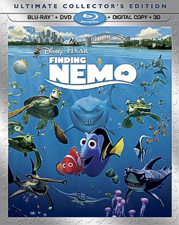 | ||
 |



